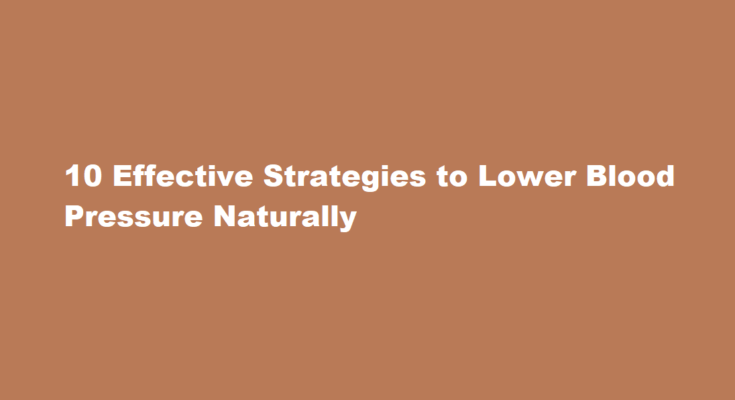Introduction
High blood pressure, or hypertension, is a prevalent health condition that can lead to serious cardiovascular complications. Fortunately, there are numerous lifestyle changes and self-care practices that can effectively lower blood pressure. In this article, we will explore ten evidence-based strategies that can help you maintain a healthy blood pressure level naturally.
Follow a Heart-Healthy Diet
A key step in managing blood pressure is adopting a balanced and nutrient-rich diet. Focus on consuming whole grains, fruits, vegetables, lean proteins, and low-fat dairy products. Reduce sodium intake by avoiding processed foods and using herbs and spices for flavor instead of salt. Incorporate potassium-rich foods like bananas, oranges, spinach, and sweet potatoes, as they help counteract the effects of sodium.
Maintain a Healthy Weight
Excess body weight puts additional strain on the cardiovascular system, leading to higher blood pressure. Shedding even a few pounds can significantly reduce hypertension risk. Embrace a well-rounded approach by combining regular physical activity with a balanced diet. Engage in aerobic exercises, such as brisk walking, cycling, or swimming, for at least 150 minutes per week to promote weight loss and improve heart health.
Exercise Regularly
Regular physical activity is crucial for overall health, including blood pressure management. Aim for a minimum of 30 minutes of moderate-intensity exercise most days of the week. Incorporate activities that raise your heart rate, such as jogging, dancing, or playing sports. Engaging in strength training exercises, like lifting weights or using resistance bands, can also be beneficial. Consult with a healthcare professional before starting any new exercise regimen.
Limit Alcohol Consumption
Excessive alcohol consumption can lead to a rise in blood pressure. If you drink alcohol, do so in moderation. Men should limit their intake to two standard drinks per day, while women should consume no more than one drink per day. Avoid binge drinking, as it can cause a sudden spike in blood pressure and other health risks.
Quit Smoking
Smoking and exposure to secondhand smoke increase blood pressure and damage blood vessels. Quitting smoking can provide immediate and long-term benefits. Seek support from healthcare professionals, join cessation programs, or consider nicotine replacement therapies. Surround yourself with a smoke-free environment and avoid triggers that may tempt you to smoke. With determination and support, you can successfully quit smoking and lower your blood pressure.
Manage Stress
Chronic stress can contribute to elevated blood pressure levels. Adopt stress-management techniques such as deep breathing exercises, meditation, yoga, or engaging in hobbies that bring you joy. Regular physical activity, getting adequate sleep, and maintaining healthy relationships also help alleviate stress. Consider seeking counseling or therapy if stress becomes overwhelming. By managing stress effectively, you can improve your overall well-being and reduce blood pressure.
Reduce Sodium Intake
High sodium intake is a leading cause of hypertension. Limit your consumption of processed and packaged foods, which are often high in sodium. Opt for fresh, unprocessed foods whenever possible, and read food labels to identify hidden sources of sodium. Gradually reduce salt added during cooking and at the table, replacing it with herbs, spices, or lemon juice to enhance flavor without raising blood pressure.
Increase Potassium-Rich Foods
Potassium plays a vital role in regulating blood pressure. Increase your intake of potassium-rich foods such as bananas, avocados, oranges, spinach, and sweet potatoes. These foods help counterbalance the effects of sodium, supporting healthy blood pressure levels. However, individuals with certain medical conditions may require medical supervision when increasing potassium intake. Consult with a healthcare professional for personalized advice.
Limit Caffeine Intake
While moderate caffeine consumption doesn’t appear to have a significant impact on blood pressure, excessive intake may raise it temporarily. Monitor your caffeine consumption and be mindful of its effects on your blood pressure. If you notice a sensitivity to caffeine, consider reducing your intake by limiting coffee, tea, energy drinks, and other caffeinated beverages.
Get Sufficient Sleep
Inadequate sleep can contribute to high blood pressure. Aim for seven to eight hours of quality sleep each night. Establish a consistent sleep routine, create a sleep-friendly environment, and practice relaxation techniques before bed. If you have sleep disorders, such as sleep apnea, seek appropriate treatment. Prioritizing quality sleep can have a positive impact on blood pressure levels and overall health.
FREQUENTLY ASKED QUESTIONS
Do bananas lower blood pressure?
Bananas. You’ve heard that an apple a day keeps the doctor away. But you might not know that a banana a day keeps high blood pressure at bay. This fruit is packed full of potassium — an important blood pressure-lowering mineral.
Which fruit is best to lower BP?
The top fruits for lowering blood pressure include bananas, apples, pears, apricots, grapes, raisins, kiwis, mangoes, watermelon, pomegranate, plums, prunes, avocado, cantaloupe, honeydew melon, tomatoes, citrus fruit, berries, and more.
Can garlic lower blood pressure?
The meta-analysis of 12 trials and 553 hypertensive participants confirmed that garlic supplements lower systolic blood pressure (SBP) by an average of 8.3±1.9 mmHg and diastolic blood pressure (DBP, n=8 trials, n=374 subjects) by 5.5±1.9 mmHg, similarly to standard anti-hypertensive medications.
Conclusion
Managing blood pressure is essential for cardiovascular health. By adopting these ten strategies, including a heart-healthy diet, regular exercise, stress management, and other healthy habits, you can effectively lower your blood pressure naturally. Always consult with your healthcare provider for personalized guidance and to monitor your progress towards achieving optimal blood pressure levels.
Read Also : Homemade Delights A Step-by-Step Guide to Making Irresistible Ice Cream



